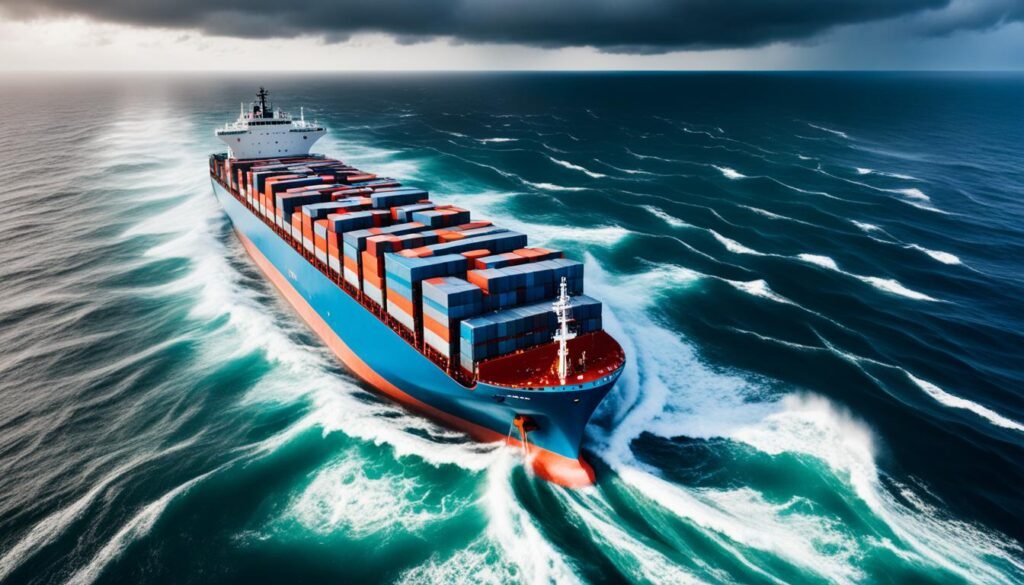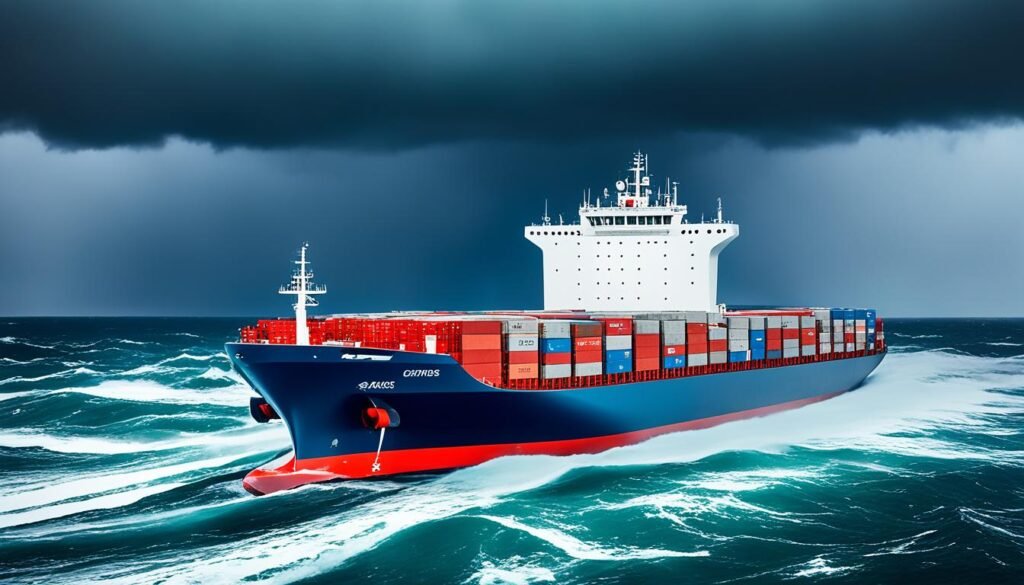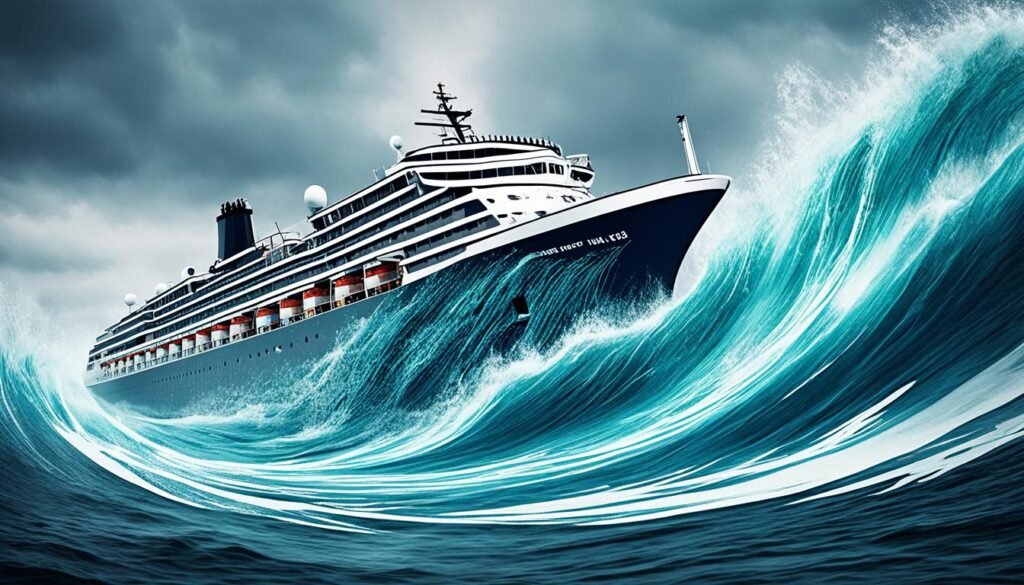The modern sailor now uses advanced tools to navigate the seas. Gone are the days of just using the stars and paper maps. Now, we have electronic charts, Automatic Identification System (AIS), and many other tools to help us sail safely.
But there’s something even more exciting happening. It’s the mix of artificial intelligence (AI) and weather forecasting. This combination is changing how we move goods safely and efficiently across the oceans.

Imagine planning your next voyage with the latest weather data and predictions. This is what AI-powered weather routing offers. It’s a new technology that’s changing the shipping world. By using AI, weather forecasts, and data analysis, sailors can navigate better. This helps avoid bad weather and keeps cargo safe and on time.
The Power of Real-Time Weather Data
Today, AI and real-time weather forecasting are changing the game in maritime navigation. They use data from satellites, buoys, and sensors to get hyper-local weather info. This includes wind, waves, currents, and storm warnings.
Integrating AI with Real-Time Weather Forecasting
This tech brings a new level of accuracy to weather forecasts at sea. It improves maritime safety and lowers the risk of accidents. AI uses lots of data to give weather updates that help ships navigate safely.
These updates help with intelligent route optimization, dynamic weather adaptation, and predictive route planning.
Enhancing Maritime Safety and Risk Mitigation
Since 1980, the U.S. has seen 377 weather and climate disasters costing over $1 billion. In 2023, 23 such events happened, says NOAA. Using metocean data integration and AI for fuel efficiency routing and emission reduction strategies can lower these risks. This makes voyages safer and greener.
| Benefit | Impact |
|---|---|
| Improved Forecasting Accuracy | Weather AI has helped airlines like JetBlue save nearly $3 million annually by offering precise forecasts of potential disruptions. |
| Enhanced Safety and Risk Mitigation | The Federal Aviation Administration (FAA) estimates that 75% of all flight disruptions are due to weather, indicating a significant impact on the maritime industry. |
| Optimized Operations and Efficiency | Businesses using AI-driven forecasting can improve safety, planning, and resource allocation, saving money and reducing downtime. |
Using real-time weather monitoring and dynamic weather data integration, the maritime industry can improve ship performance and planning. This leads to better fuel efficiency enhancement and emissions reduction.

Dynamic Digital Charts
AI is changing how we navigate, going beyond predictive weather modeling and sustainable transportation solutions. Now, it’s making maps for ships that change as conditions do. These maps show dangers like sudden storms or thick fog. They use machine learning weather predictions and real-time weather data integration to update ocean conditions.
Adaptive Maps Displaying Potential Hazards
This means ships can navigate safely through tough waters with AI’s help. These systems look ahead to find ways to save fuel and cut down on pollution. They offer a new way to navigate that’s safer and smarter than before.
Integrating AI Analytics with Experienced Navigators
By combining predictive maintenance for vehicles, intelligent fleet management systems, and meteorological data analytics, these charts give captains a big edge. They mix AI and human knowledge to make safer and more efficient trips at sea.

Personalized Voyages and Nautical AI Applications
The future of maritime navigation is set to offer a personalized experience. AI-powered apps will tailor voyages to fit your preferences. Imagine journeys that are safer, more efficient, and tailored just for you, making navigation a unique experience.
With AI weather prediction, dynamic aviation navigation, and real-time weather forecasting, nautical AI can offer personalized voyages. These systems consider many factors. They help you navigate safely and efficiently, thanks to weather-optimized flight paths and climate-aware routing.
AI-driven nautical apps use predictive weather analysis for aviation and meteorological analytics. They provide solutions that fit your needs. Whether you care about saving fuel, reducing environmental impact, or making timely arrivals, these systems can help. They create voyages that match your preferences.
The future of maritime navigation is about more than just reaching your destination. It’s about taking control of your journey. With AI-driven airspace management and autonomous navigation systems, you’ll enjoy a more personalized and weather-optimized flight path experience. Every part of your voyage will be tailored to your needs.
| AI-Powered Feature | Key Benefit |
|---|---|
| Dynamic Route Planning | Optimized voyages considering weather, environmental factors, and individual preferences |
| Predictive Weather Analytics | Proactive risk mitigation and enhanced safety through real-time weather monitoring |
| Autonomous Navigation | Personalized voyages tailored to user needs, including fuel efficiency and on-time arrivals |
The future of maritime navigation is AI-powered. It combines cutting-edge tech with your preferences for a personalized experience. From weather data integration to predictive analytics, the possibilities are endless. We’re entering a new era of intelligent, user-centric maritime voyages.
AI-Powered Weather Routing: Transforming the Maritime Industry
Artificial intelligence (AI) is changing the maritime industry in big ways. It’s making operations more efficient, sustainable, and safe. AI-powered weather routing is a key technology that’s changing how cargo ships plan and travel.
Boosted Efficiency through Optimized Routes
AI uses lots of weather data and advanced analytics to find the best routes for cargo ships. This means ships travel faster, use less fuel, and emit less carbon. The International Maritime Organization (IMO) says AI could cut CO2 emissions by 10%.
Empowered Decision-Making with AI Insights
AI doesn’t replace human skills; it makes them better. Captains get real-time AI insights to make smarter decisions. This mix of human know-how and AI helps ensure safer, more efficient trips.
Using flight planning software, weather forecasts, and real-time support, the maritime industry is set for a big change. AI and human skills together are making shipping more sustainable and efficient.
Merging the Power of AI and Weather Data
AI is changing how we use data. It has a lot of weather info and can change industries fast. Using AI’s predictions is key to staying ahead in today’s data world.
AI’s Predictive Power and the Onslaught of Data
AI in maritime navigation uses weather pattern analysis and lots of weather data. It looks at past and current weather data to make predictions for safer flights. The quality of the data is crucial for accurate AI forecasts, coming from sources like satellites and buoys.
Achieving AI-powered Weather Prediction for Navigation Charts
Combining lots of data is key to making good weather predictions for navigation charts. AI’s machine learning forecasting and lots of data change how we see and handle weather. This mix helps with predictive flight planning and climate impact mitigation, changing maritime travel, and more.
| Key AI Capabilities | Impact on Weather Forecasting |
|---|---|
| Machine learning forecasting Predictive flight planning Atmospheric data integration | Improved accuracy in weather predictions Enhanced flight safety enhancements and fuel efficiency algorithms Better understanding of climate impact mitigation |
AI and weather data together are changing how we see and deal with global weather. They help with aviation route optimization and real-time rerouting capabilities. This mix is making the maritime industry safer, more sustainable, and adaptable for the future.
The Output of AI Analysis
AI uses weather data analysis, machine learning algorithms, and meteorological modeling to give valuable insights for ships. These tools help predict the weather, making it safer and more efficient for flying.
Suggesting Alternative Routes
AI quickly looks at real-time weather data to find new paths. This helps avoid dangers like storms, fog, or strong currents. It helps ships stay safe and keep their cargo safe too.
Warning of Potential Hazards
AI-powered navigation charts warn of weather dangers in real time. They use machine learning flight operations to send alerts. These warnings help avoid turbulence and other weather issues, making flying safer and reducing delays.
Optimizing Fuel Efficiency
AI also helps save fuel and reduce environmental impact. It looks at wind, currents, and weather to find the best routes. This leads to lower costs and less harm to the planet.
Achieving the Vision: Enhanced Safety, Sustainable Seas
The use of real-time traffic optimization, predictive travel planning, and automated navigation systems is changing the maritime industry. These systems use smart logistics solutions and meteorological data analysis to improve safety and sustainability at sea.
AI helps predict and avoid dangers at sea. By looking at weather pattern data and aviation route optimization, these systems can change routes in real time. This reduces the risk of accidents and keeps people safe, helping the maritime industry thrive.
AI also makes flying more efficient and helps the environment. By using machine learning forecasting and predictive flight planning, these systems find the best routes. This cuts down on fuel use and emissions, making maritime travel more sustainable.
Improving aircraft safety and intelligent path optimization makes maritime transport safer and more efficient. Logistics automation and adaptive transportation solutions help systems adapt to changes, ensuring safety and efficiency.
AI is changing the maritime industry for the better. It’s making seas safer and more sustainable. With predictive travel planning, automated navigation systems, and smart logistics solutions, the industry is ready for the future.
You can check out this blog post on AI unlocks weather routing potential for relevancy.
Conclusion
AI and weather forecasting are changing maritime navigation for the better. They make it safer, more efficient, and greener. Real-time weather data and AI systems give accurate predictions and dynamic route optimization. This helps captains navigate safely through tough waters.
By combining human skills with AI analytics, we get a powerful team. This team is changing the maritime industry for the better. It’s making voyages safer, cutting down on environmental harm, and improving logistics.
The use of AI technologies with weather forecasting starts a new era of precision and reliability. This benefits many fields such as aviation, agriculture, and disaster management. It’s a big step forward.
Companies should look into how AI-generated weather data stacks up in terms of accuracy, timeliness, verification, explainability, and forecast availability. This will help them use new tech wisely and handle extreme weather conditions better.
As the maritime industry takes on this new tech, we’re looking at a future full of safety, efficiency, and environmental sustainability. It’s setting a new standard for global transportation.
FAQ
What is the role of AI in maritime weather routing?
AI uses real-time weather data to make accurate predictions. It helps optimize routes and warn of hazards early. This makes sailing safer, more efficient, and greener.
How does the integration of AI and weather forecasting improve maritime navigation?
AI systems use real-time weather data for accurate predictions and route optimization. They give captains early warnings. This helps them navigate safely through rough waters.
What are the benefits of AI-powered digital charts in maritime navigation?
AI-powered digital charts show potential hazards and use experienced captains’ knowledge. They act like a digital co-captain, guiding ships safely through danger.
How does AI enable personalized voyages in the maritime industry?
AI lets captains plan trips based on safety, efficiency, and personal needs. This makes sailing more tailored to each captain’s preferences.
How does the integration of AI and weather data enhance maritime safety?
AI gives early warnings and adjusts routes in real time. This greatly lowers the risk of accidents at sea. It protects lives and supports maritime jobs.
You can also read
